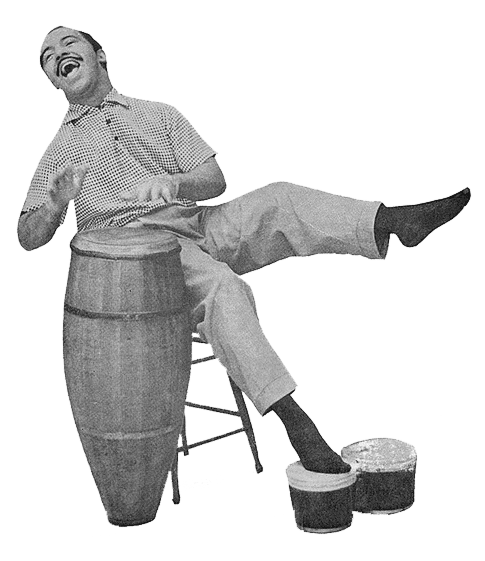
History
Modern mambo began with a song called "Mambo" written in 1938 by brothers Orestes and Cachao López. The song was a danzón, a dance form descended from European social dances like the English country dance, French contredanse, and Spanish contradanza. It was backed by rhythms derived from African folk music.
Orgins (Contradanza and Charanga)
Contradanza arrived in Cuba in the 18th century, where it became known as danza and grew very popular. The arrival of black Haitians later that century changed the face of contradanza, adding a syncopation called cinquillo (which is also found in another contradanza-derivative, Argentine tango).
By the end of the 19th century, contradanza had grown lively and energetic, unlike its European counterpart, and was then known as danzón. The 1877 song "Las alturas de Simpson" was one of many tunes that created a wave of popularity for danzón. One part of the danzón was a coda which became improvised overtime. The bands then were brass (orquestra tipica), but was followed by smaller groups called charangas.
The most influential charanga was that of Antonio Arcano, who flourished in the late 1930s. Arcano's group, Arcano y Sus Maravillas, was the first to call a part of a popular Cuban dance a mambo. His group was already saying vamos a mambear, which translates to "let's mambo", in the mid-to-late 1930s. It was Arcano's cellist, Orestes Lopez, whose "Mambo" was the first modern song of the genre. However, the first mambo that was actually recorded was called "Rarezas" by his brother, bassist and composer Cachao López, who is often described as "the inventor of mambo."
Mexico
In 1948, hoping to gain more success, Perez Prado moved to Mexico City and started his own band, where he composed and recorded most of mambos. Perez Prado, dedicated primarily to Mambo, started being called El Rey del Mambo, and he appeared in several Mexican Films. He composed and played several songs inspired by the life style of Mexico City, like "Dengue Universitario" and "Mambo Universitario" dedicated to the UNAM; "Guada Guadalupe", "Lupita" and "Norma la de Guadalajara" inspired by Mexican women; and "Mambo del Ruletero", where he names different neighborhoods of the city. He also covered Mexican songs, like "Maria Bonita", "Besame Mucho", "La Raspa", Angelitos Negros, and "Granada (song)". Later in the 1950s Perez Prado acquired the Mexican Citizenship, moved to New York for some years, and then returned to Mexico City, where he died on September 14, 1989, aged 72.
Beny Moré also lived in Mexico between 1945 and 1952; it was there where people started calling him Beny or Benny instead of Bartolo. He composed and recorded some Mambos in Mexico, with Mexican orchestras, eecially with the one directed by Rafael de Paz; they recorded Yiri yiri bon, La Culebra, Mata siguaraya, Solamente una vez and "Bonito y Sabroso", a song where he praises the dancing skills of the Mexicans, and claims that Mexico City and La Habana are sister cities. Also in Mexico, Benny and Perez Prado recorded several mambos including "La mucura", "Rabo y oreja", and "Pachito e che" . In this time Benny also recorded with the orchestra of Jesús "Chucho" Rodríguez. El "Chucho" was so impressed with Benny's musical ability that he referred to him as "El Barbaro del Ritmo".
Prado's recordings were meant for the Latin American and U.S. Latino markets, but some of his most celebrated mambos, such as "Mambo No. 5" and "Que Rico el Mambo", quickly crossed over to the United States.
New York City
In the 1950s New York City began to publish articles on an emerging "mambo revolution" in music and dance. Recording companies began to use mambo to label their records and advertisements for mambo dance lessons were in local newspapers. New York City had made mambo a transnational popular cultural phenomenon. By the mid-1950s mambo mania had reached fever pitch. In New York the mambo was played in a high-strung, sophisticated way that had the Palladium Ballroom, the famous Broadway dance-hall, jumping. The Ballroom soon proclaimed itself the "temple of mambo", for the city's best dancers—the Mambo Aces, "Killer Joe" Piro, Augie and Margo Rodriguez, Paulito and Lilon, Louie Maquina and Pedro "Cuban Pete" Aguilar—gave mambo demonstrations there and made a reputation for their expressive use of arms, legs, head and hands. Augie and Margo became the highest paid dance duo in the world and still dance in Las Vegas 50 years later (2006).
Some of New York's biggest mambo dancers and bands of the 1950s included: Augie & Margo, Michael Terrace & Elita, Carmen Cruz & Gene Ortiz, Larry Selon Vera Rodriguez, Mambo Aces(Anibal Vasquez y samson Batalla), Killer Joe Piro, Paulito and Lilon, Louie Maquina, Pedro Aguilar ("Cuban Pete"), Machito, Tito Rodríguez, Jose Curbelo, Akohh, and Noro Morales.
Cha-Cha-Cha
In 1954, the cha-cha-chá, a kind of mambo, swept through Havana. Cha-cha-cha was created by the Cuban violinist Enrique Jorrín, a member of the Orquesta América. Easier to dance than the mambo, with a squarish beat and a characteristic hiccup on the fourth beat, it spread to Europe.